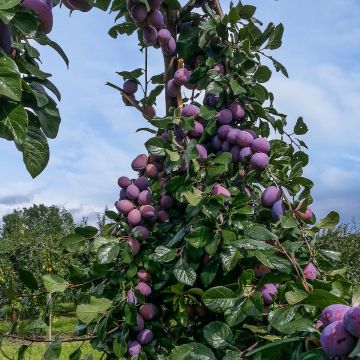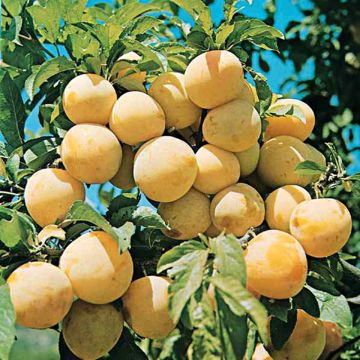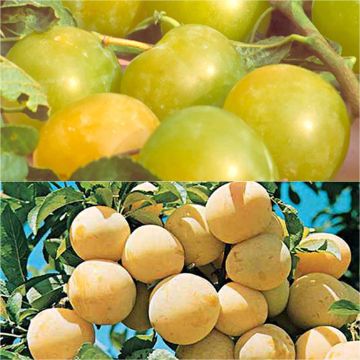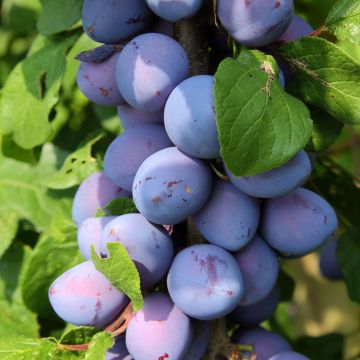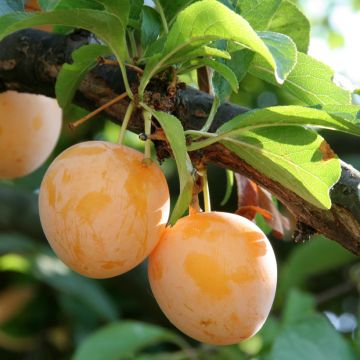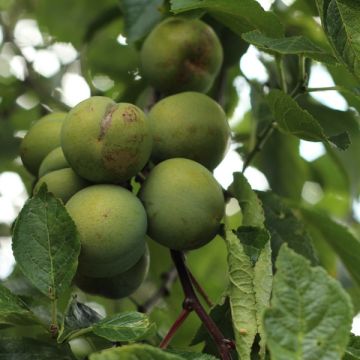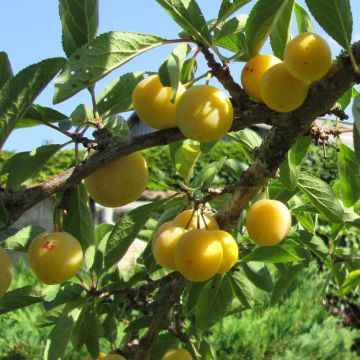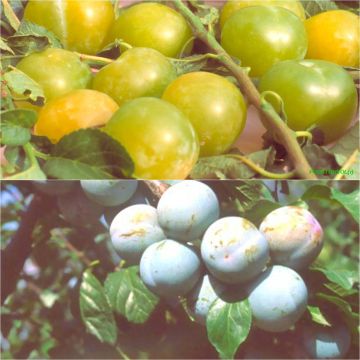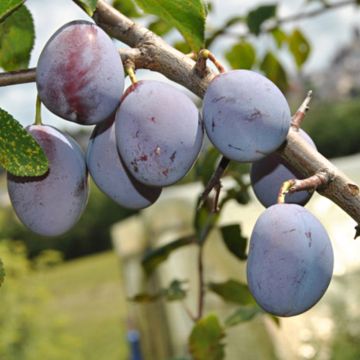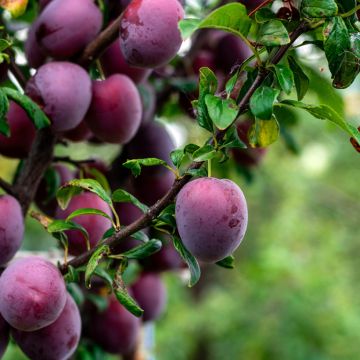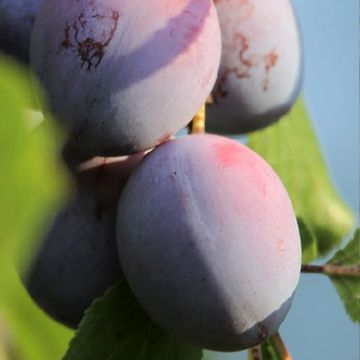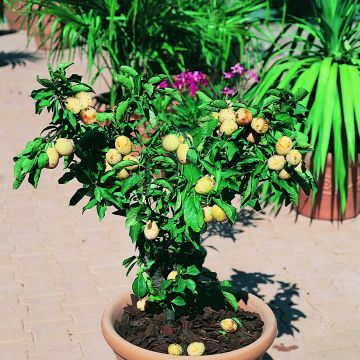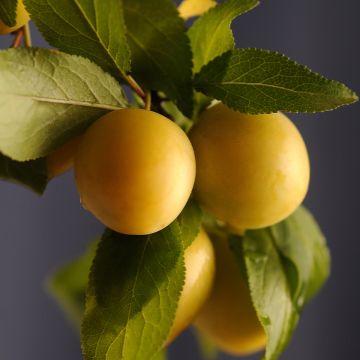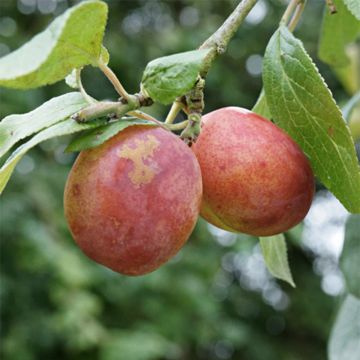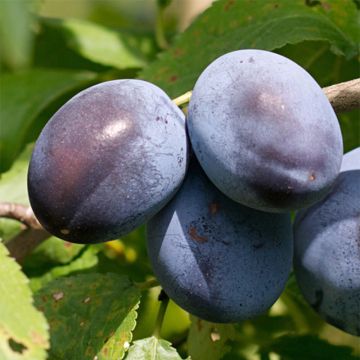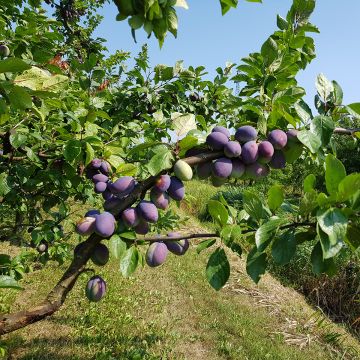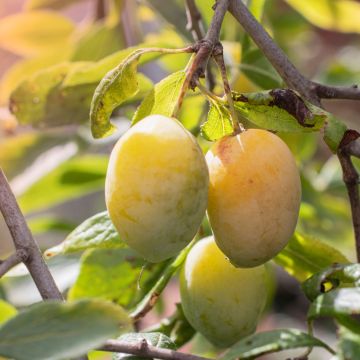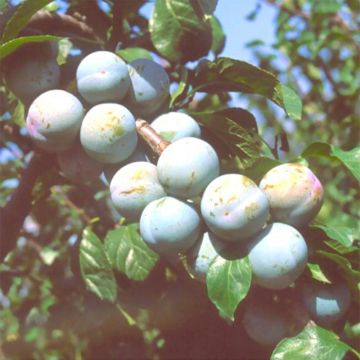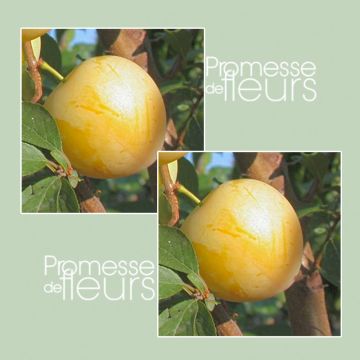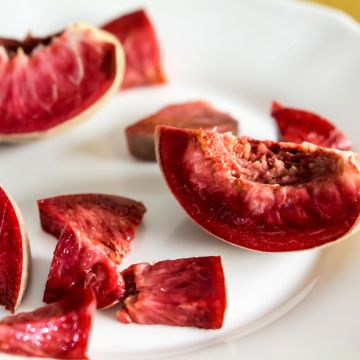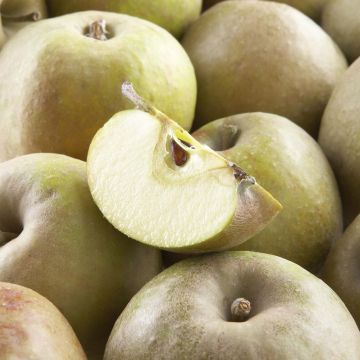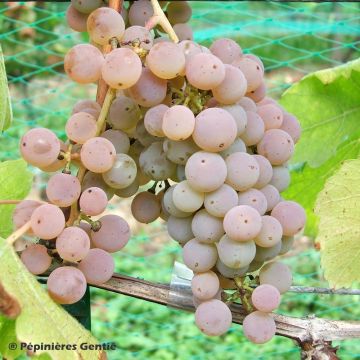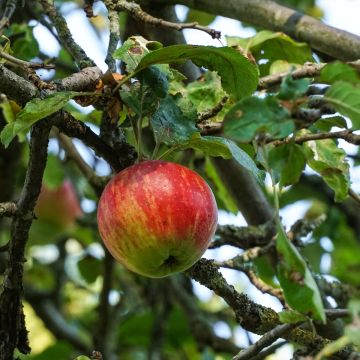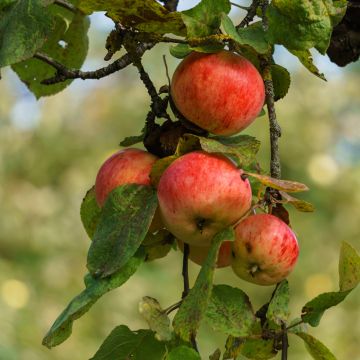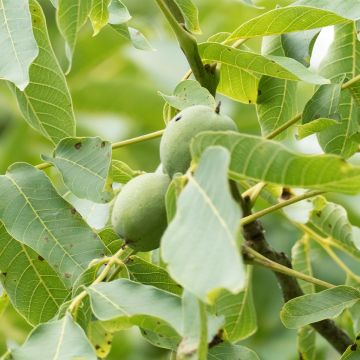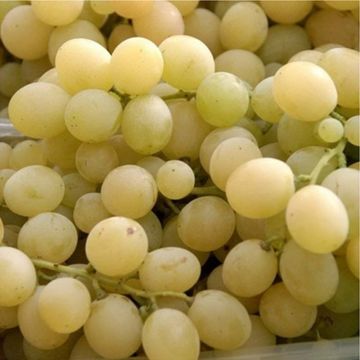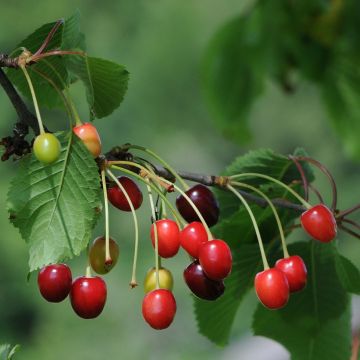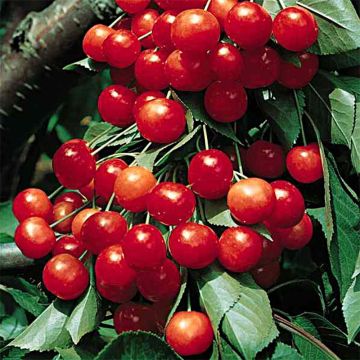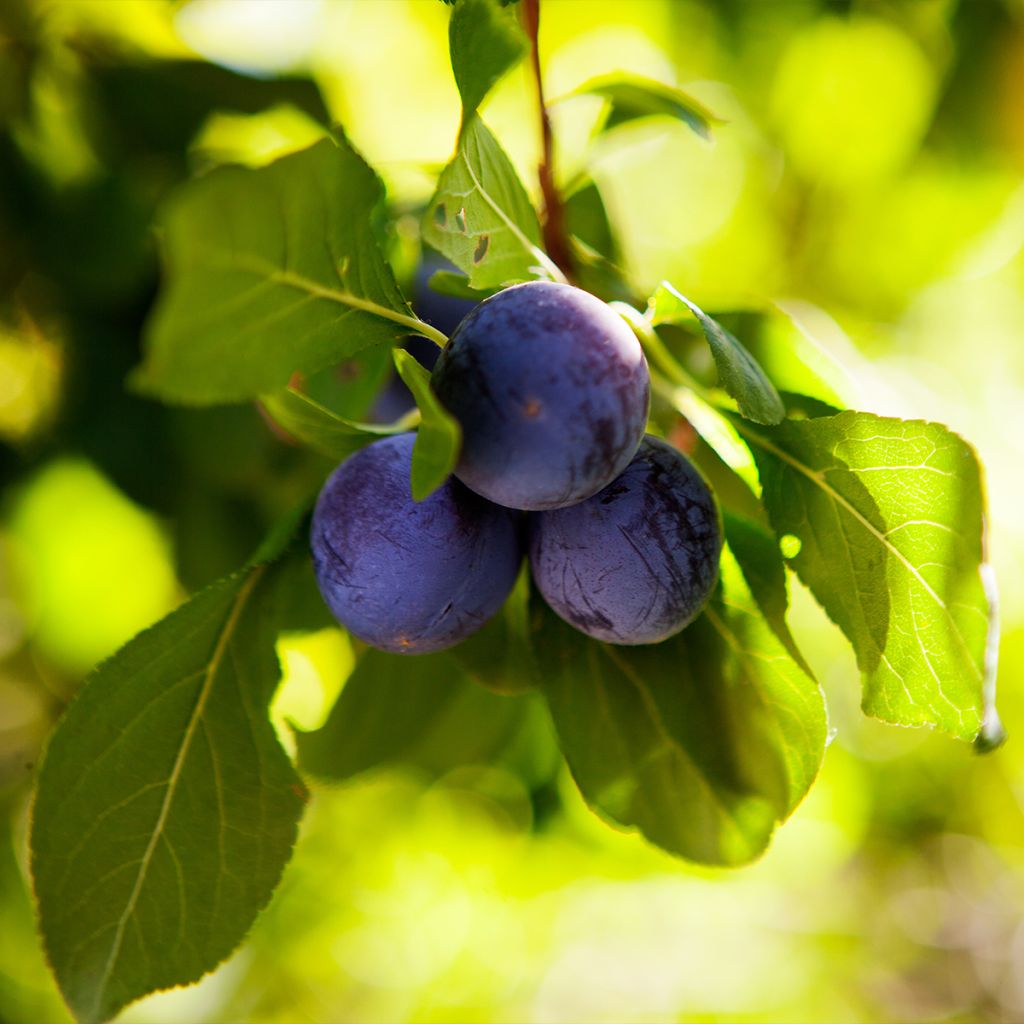

Prunus domestica Perdrigon - Common plum
Prunus domestica Perdrigon - Common plum
Prunus domestica Perdrigon
European plum, Common plum, Garden plum
Why not try an alternative variety in stock?
View all →This plant carries a 6 months recovery warranty
More information
We guarantee the quality of our plants for a full growing cycle, and will replace at our expense any plant that fails to recover under normal climatic and planting conditions.
Oversize package: home delivery by special carrier from €6.90 per order..
Express home delivery from €8.90.
Delivery to Corse prohibited: UE law prohibits the import of this plant from mainland France to Corse as part of the fight against Xylella fastidiosa. Please accept our sincere apologies.
More information
Description
Prunus domestica 'Perdrigon' is a variety of plum tree that once thrived in Provence, providing the famous prune plums from Var. This ancient variety with its short flowering period in late March produces small to moderate-sized fruits, which are blue-violet in colour and have relatively thick skin, covering a sweet flesh. They can be eaten fresh, dried (as the famous pistoles), or used in tarts or jams.
Plum trees are part of the extensive Rosaceae family, which includes most of our temperate fruit trees (such as apple trees, pear trees, apricot trees, peach trees, cherry trees, quince trees) as well as small fruits (blackberries, raspberries, strawberries). The original Prunus domestica is probably native to Asia Minor (Syria) and would have been introduced to Rome, along with many other species, as a result of Roman conquests. According to some authors, its introduction to Europe is more likely due to the Crusades, but who really knows?
'Perdrigon' is a variety of unknown origin, cultivated since at least 1582 (it has been present in the Potager du Roi in Versailles since the 17th century) and has had a somewhat meandering history. Also known as 'Perdrigon Violet', this plum was cultivated, abandoned, and then cultivated again in a series of periods. A major production centre was located in Brignoles in Var, where it produced the famous pistoles, dried fruits that resembled the shape of this ancient currency. Named Pardigouno in Provençal, the Prune of Brignoles eventually disappeared into the depths of history, but for the past twenty years, associations in Var have been working to revive its local production with the aim of obtaining a Protected Geographical Indication (PGI).
This historic plum tree is a medium-sized tree, reaching up to 7m (23ft) in height, with a relatively spreading habit (up to 6m (20ft)). It blooms abundantly but briefly in late March/early April, much to the delight of bees that ensure its pollination. This flowering period is quite sensitive to late frosts, so it is good to shelter this tree from cold winds, for example by planting it near a sun-exposed stone wall. These single flowers with five white petals develop into small to medium-sized fruits (drupe) with an oval shape and a dark blue-violet colour. They are covered with a bloom that helps protect against drying out. They are ready to be harvested in late August and can be eaten fresh, although their skin is quite thick and their yellow flesh is slightly acidic. That's why they were dried to produce Provence prunes. These plums can also be used in desserts, tarts, or jams. In general, plums are rich in antioxidants, vitamin B9, iron, and magnesium; they are also high in fiber and stimulate intestinal transit (everyone knows the effects of dried prunes!). Moreover, they are low in calories and not too rich in carbohydrates (fresh ones, that is, not dried prunes!).
'Perdrigon' grows in deep and rather moist soil, in neutral to limestone terrain. It is susceptible to cold winter winds, although it is hardy down to about -17°C (1.4°F), so it needs a sunny exposure. However, it should be kept in mind that the plum tree needs to experience cold to bear fruit (what is called vernalization, translated into a certain number of essential hours of cold). With cold winters and plenty of sunshine, it's no wonder that Brignoles' contrasting climate has become its adopted land!
'Perdrigon' is a highly productive and biennially bearing variety (meaning it has little variation in production from one year to the next). To obtain good harvests, plant other varieties of plum trees alongside it, as cross-pollination is always beneficial. To fully enjoy the pleasures of summer, plant some vines, such as the 'Chasselas Doré', which will thrive in the same types of soil and climate conditions as 'Perdrigon' and delight you with its clusters of sweet grapes.
Report an error about the product description
Prunus domestica Perdrigon - Common plum in pictures
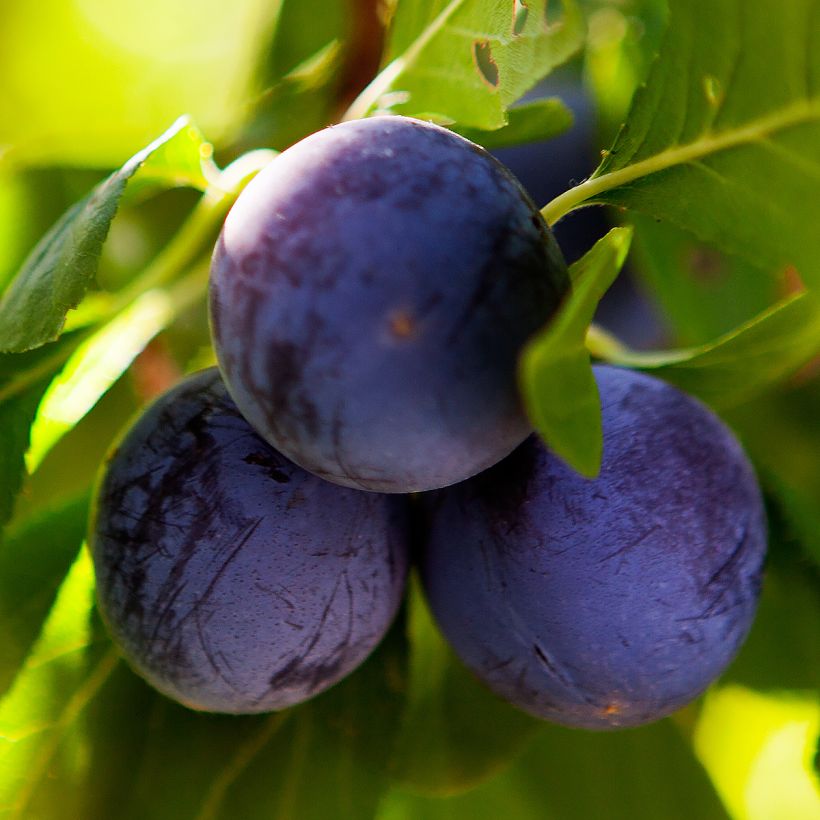

Plant habit
Fruit
Flowering
Foliage
Botanical data
Prunus
domestica
Perdrigon
Rosaceae
European plum, Common plum, Garden plum
Cultivar or hybrid
Other Plum Trees
Planting and care
The 'Perdrigon' Plum prefers to grow in deep clay-limestone soil, but it can adapt to other types of soil. However, it is quite demanding in terms of sunlight, and while it is hardy (down to approximately -17 °C, or even lower), it does not like to be exposed to winter winds. Therefore, it is important to carefully choose its location from the start. Then, dig a planting hole of at least 50 cm (20in) on all sides, and even more, as this tree prefers deep soils. It also appreciates some moisture, so make sure to water it regularly in summer and autumn during the first few years. Once well rooted, it is a resilient and low-maintenance tree.
Planting period
Intended location
Care
This item has not been reviewed yet - be the first to leave a review about it.
Ancient and local varieties
Haven't found what you were looking for?
Hardiness is the lowest winter temperature a plant can endure without suffering serious damage or even dying. However, hardiness is affected by location (a sheltered area, such as a patio), protection (winter cover) and soil type (hardiness is improved by well-drained soil).

Photo Sharing Terms & Conditions
In order to encourage gardeners to interact and share their experiences, Promesse de fleurs offers various media enabling content to be uploaded onto its Site - in particular via the ‘Photo sharing’ module.
The User agrees to refrain from:
- Posting any content that is illegal, prejudicial, insulting, racist, inciteful to hatred, revisionist, contrary to public decency, that infringes on privacy or on the privacy rights of third parties, in particular the publicity rights of persons and goods, intellectual property rights, or the right to privacy.
- Submitting content on behalf of a third party;
- Impersonate the identity of a third party and/or publish any personal information about a third party;
In general, the User undertakes to refrain from any unethical behaviour.
All Content (in particular text, comments, files, images, photos, videos, creative works, etc.), which may be subject to property or intellectual property rights, image or other private rights, shall remain the property of the User, subject to the limited rights granted by the terms of the licence granted by Promesse de fleurs as stated below. Users are at liberty to publish or not to publish such Content on the Site, notably via the ‘Photo Sharing’ facility, and accept that this Content shall be made public and freely accessible, notably on the Internet.
Users further acknowledge, undertake to have ,and guarantee that they hold all necessary rights and permissions to publish such material on the Site, in particular with regard to the legislation in force pertaining to any privacy, property, intellectual property, image, or contractual rights, or rights of any other nature. By publishing such Content on the Site, Users acknowledge accepting full liability as publishers of the Content within the meaning of the law, and grant Promesse de fleurs, free of charge, an inclusive, worldwide licence for the said Content for the entire duration of its publication, including all reproduction, representation, up/downloading, displaying, performing, transmission, and storage rights.
Users also grant permission for their name to be linked to the Content and accept that this link may not always be made available.
By engaging in posting material, Users consent to their Content becoming automatically accessible on the Internet, in particular on other sites and/or blogs and/or web pages of the Promesse de fleurs site, including in particular social pages and the Promesse de fleurs catalogue.
Users may secure the removal of entrusted content free of charge by issuing a simple request via our contact form.
The flowering period indicated on our website applies to countries and regions located in USDA zone 8 (France, the United Kingdom, Ireland, the Netherlands, etc.)
It will vary according to where you live:
- In zones 9 to 10 (Italy, Spain, Greece, etc.), flowering will occur about 2 to 4 weeks earlier.
- In zones 6 to 7 (Germany, Poland, Slovenia, and lower mountainous regions), flowering will be delayed by 2 to 3 weeks.
- In zone 5 (Central Europe, Scandinavia), blooming will be delayed by 3 to 5 weeks.
In temperate climates, pruning of spring-flowering shrubs (forsythia, spireas, etc.) should be done just after flowering.
Pruning of summer-flowering shrubs (Indian Lilac, Perovskia, etc.) can be done in winter or spring.
In cold regions as well as with frost-sensitive plants, avoid pruning too early when severe frosts may still occur.
The planting period indicated on our website applies to countries and regions located in USDA zone 8 (France, United Kingdom, Ireland, Netherlands).
It will vary according to where you live:
- In Mediterranean zones (Marseille, Madrid, Milan, etc.), autumn and winter are the best planting periods.
- In continental zones (Strasbourg, Munich, Vienna, etc.), delay planting by 2 to 3 weeks in spring and bring it forward by 2 to 4 weeks in autumn.
- In mountainous regions (the Alps, Pyrenees, Carpathians, etc.), it is best to plant in late spring (May-June) or late summer (August-September).
The harvesting period indicated on our website applies to countries and regions in USDA zone 8 (France, England, Ireland, the Netherlands).
In colder areas (Scandinavia, Poland, Austria...) fruit and vegetable harvests are likely to be delayed by 3-4 weeks.
In warmer areas (Italy, Spain, Greece, etc.), harvesting will probably take place earlier, depending on weather conditions.
The sowing periods indicated on our website apply to countries and regions within USDA Zone 8 (France, UK, Ireland, Netherlands).
In colder areas (Scandinavia, Poland, Austria...), delay any outdoor sowing by 3-4 weeks, or sow under glass.
In warmer climes (Italy, Spain, Greece, etc.), bring outdoor sowing forward by a few weeks.


































